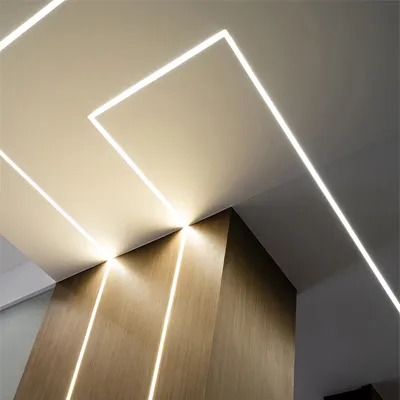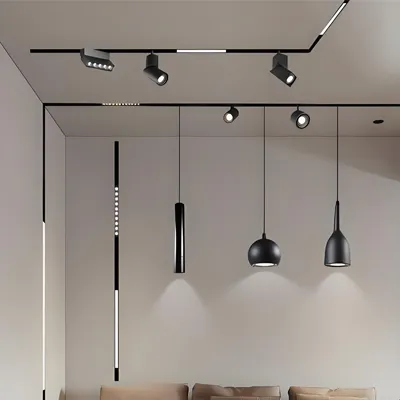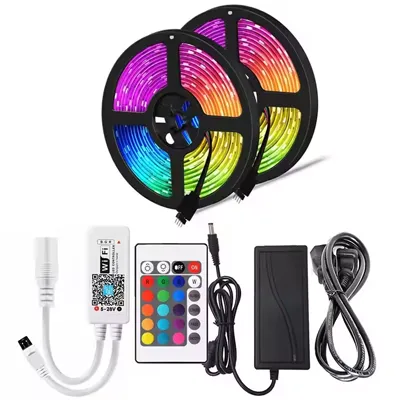Seeing that flicker in your LED lights? You're likely asking: are flickering led lights dangerous? It’s a common question now that LEDs are standard. Sometimes it's just an annoying mismatch with an old dimmer. But ignore persistent flickering, and you might be overlooking potential health effects like headaches, or even missing a warning sign of hazardous electrical issues brewing in your walls. Let's sort through the noise. Here’s what you need to know about the risks, the causes, and what action to take.
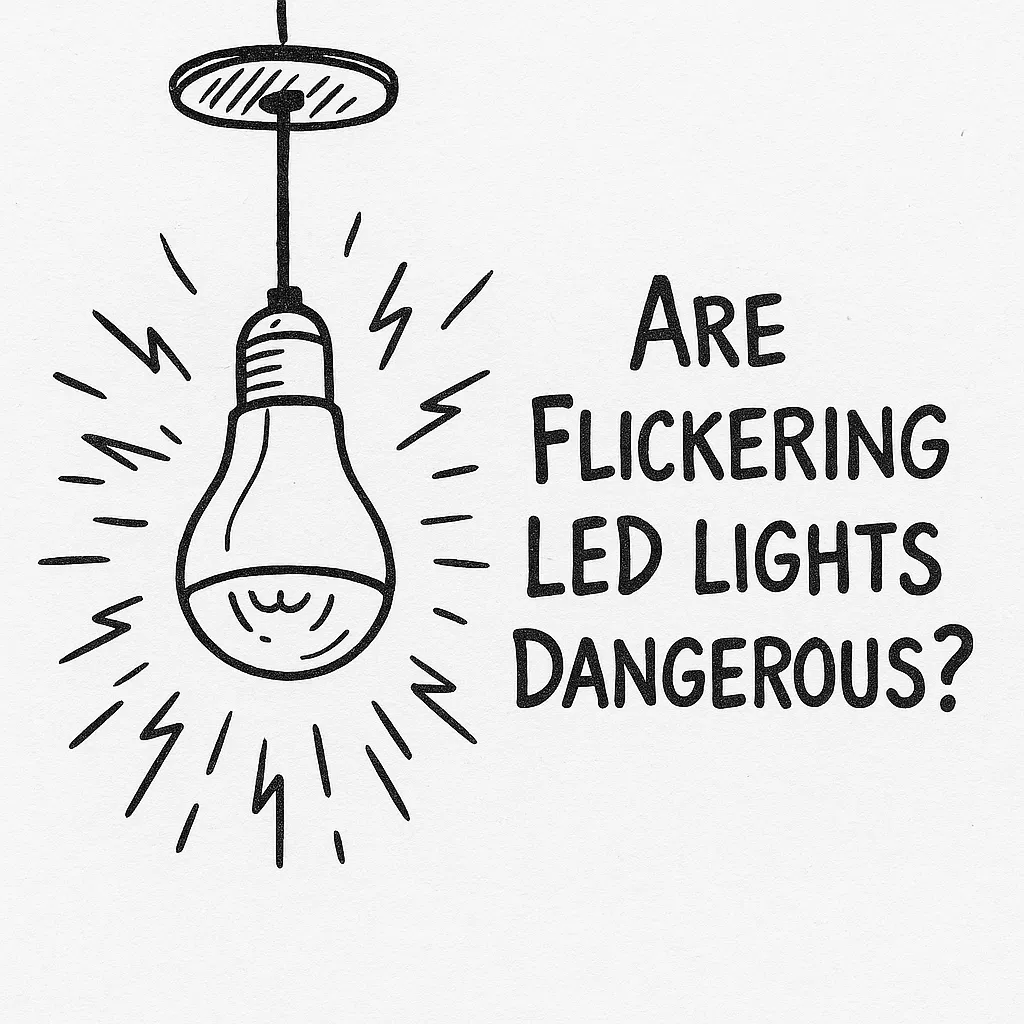
How Flickering LEDs Might Affect Your Well-being
Let's be upfront: for many people, the flicker from an LED light is mostly just irritating. But that doesn't mean it's harmless across the board. Certain types of flicker, especially those invisible to the naked eye but picked up by our brains (often from lower-quality drivers or poor AC-DC conversion), can contribute to real physical discomfort. You might experience:
- Headaches or Migraines: Some individuals find that exposure to flickering light sources triggers or worsens headaches.
- Eye Strain and Fatigue: Your eyes constantly try to adapt to the fluctuating light level, leading to tiredness, dryness, or a feeling of strain, especially during focused tasks.
- Reduced Visual Performance: Flicker can subtly interfere with visual perception, potentially affecting reading speed or task accuracy.
- Dizziness or Vertigo: In sensitive individuals, pronounced flicker or stroboscopic effects (where moving objects appear jerky) might induce feelings of dizziness or disorientation.
Now, there are specific groups who need to be particularly aware. If you or someone in your household has photosensitive epilepsy, certain flicker frequencies can pose a genuine seizure risk. Likewise, those prone to migraines might find flicker to be a significant trigger. While not an immediate "danger" for most, discounting these potential health effects, especially with prolonged exposure, isn't advisable.
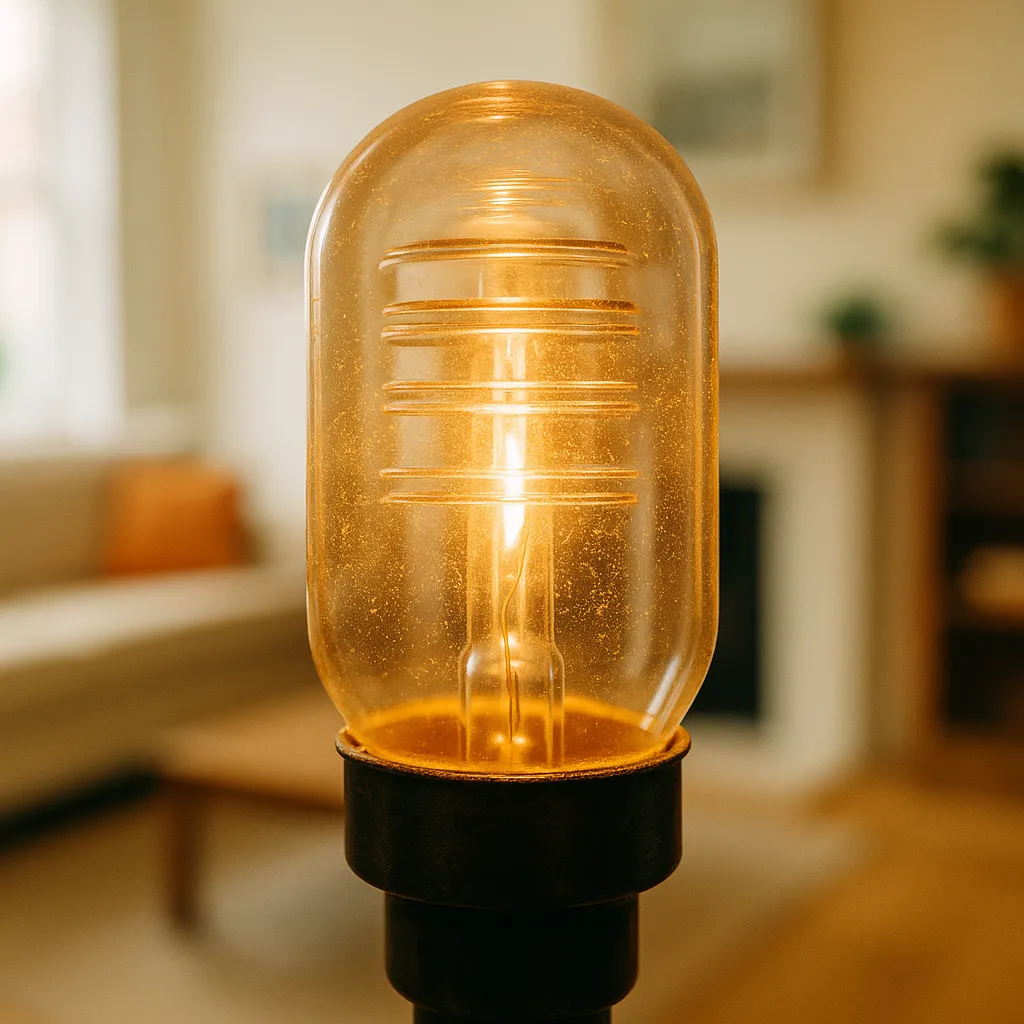
Understanding the Link Between Flicker and Fire Safety
This is often the biggest worry: Could that flickering light start a fire? Let's get this straight: the flicker itself, the light pulsing on and off, is not going to spontaneously combust. However, persistent or specific types of flickering can absolutely be a symptom of an underlying electrical problem that does carry a fire risk. Think of the flicker as a warning light on your dashboard.
Here's where the real danger lies:
- Faulty Wiring: This is the main concern. Loose connections in the light fixture, the switch box, or junction boxes behind the walls can cause intermittent contact. This arcing or poor connection generates heat. Enough heat over time, near flammable materials (like wood framing or insulation), is a classic recipe for an electrical fire. The flickering light is your visible clue that this might be happening.
- Overheating Components: A failing LED driver or a poorly designed fixture might overheat as it struggles to regulate power. While quality LEDs have safeguards, a malfunctioning component generating excessive heat is never a safe situation. The flicker could be a sign of the component failing under stress.
- Damaged Insulation: Wires with cracked or damaged insulation can lead to shorts or arcing, again creating heat and fire risk. Flicker might occur as the connection breaks and makes intermittently.
So, while a flicker due to an incompatible dimmer is usually just annoying, flicker caused by bad wiring is a serious safety issue that needs immediate attention. You have to consider the cause to assess the fire risk.
When Flicker Signals Broader Electrical Issues
Sometimes, that flickering LED isn't just about the bulb or its immediate connection. It can be a canary in the coal mine, hinting at problems within your home's wider electrical system. If you notice flicker, especially if it affects multiple lights or seems related to other electrical events, consider these possibilities:
- Voltage Fluctuations: Your home's voltage isn't always perfectly stable. Large appliances kicking on (like an air conditioner, refrigerator, or vacuum cleaner) can cause temporary voltage dips on a circuit. If your LEDs flicker noticeably during these events, it might indicate the circuit is heavily loaded or the incoming voltage isn't as stable as it should be. While often benign, severe or frequent fluctuations aren't ideal for sensitive electronics.
- Overloaded Circuits: Too many devices drawing power on a single circuit can lead to voltage drops and potentially cause lights to flicker or dim, especially under heavy load. This also puts stress on the circuit breaker and wiring.
- Loose Neutral Connection: A problematic neutral connection, either in your main electrical panel or somewhere along the circuit, can cause strange voltage issues and flickering lights across multiple circuits. This is a potentially hazardous situation that requires professional diagnosis.
- Utility Company Issues: Though less common, sometimes the problem might originate from the power grid itself, causing voltage instability that manifests as flickering lights throughout the house.
Observing how and when the flicker occurs can provide clues. Does it affect one light or many? Does it happen randomly or when specific appliances run? This information is valuable, whether you're troubleshooting yourself or explaining the situation to an electrician.
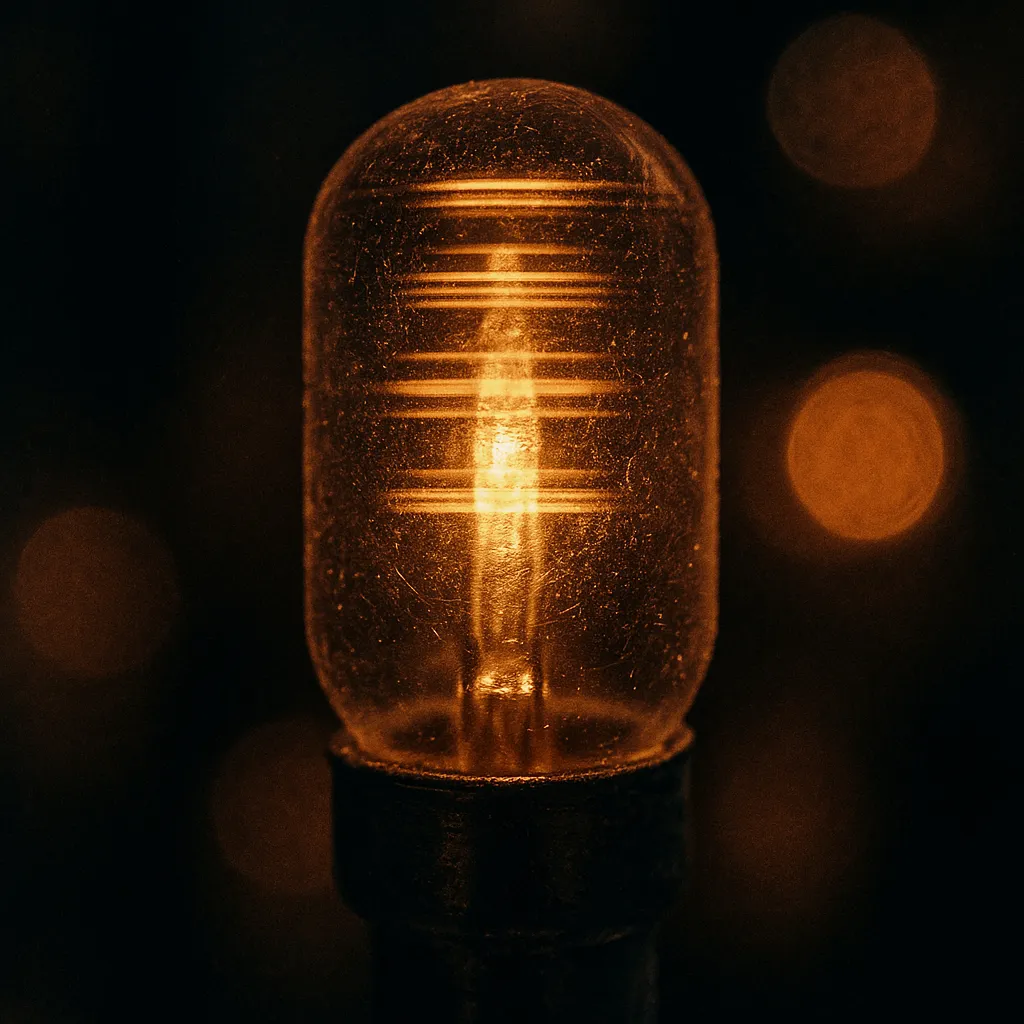
Finding the Root Cause of Your Flickering LEDs
Alright, the flicker's happening. Job one is figuring out why. Different causes demand different solutions, so accurate diagnosis matters. Here’s where to look first:
Dealing with Dimmer Switches
Often the prime suspect, especially if you've put LEDs on a circuit previously using incandescent bulbs with an older dimmer.
- The Incompatibility Issue: Older TRIAC-based dimmers expect the higher load of incandescent bulbs. LEDs draw far less power and need different dimming technology (often trailing-edge, ELV, or MLV types). This mismatch frequently causes flicker, buzzing, or a limited dimming range. It’s not just about whether the dimmer works at all, but whether it works smoothly with the low load of LEDs.
- Component Quality: Even with "LED compatible" labels, budget dimmers or very inexpensive LED bulbs might lack the sophisticated circuitry needed for smooth, flicker-free operation, especially noticeable at lower brightness settings. Compatibility claims don't always translate to perfect real-world performance across all brand combinations.
Flicker Without a Dimmer
If a dimmer isn't in the picture, investigate these possibilities:
- LED Driver Performance: The driver circuit inside the bulb or fixture converts AC household power to the DC needed by the LED. Low-cost or poorly engineered drivers are a primary source of flicker, sometimes immediate, sometimes developing over time. A driver nearing failure often manifests as flicker before the LED dies completely – so yes, flicker can precede burnout, usually indicating the driver is the failing component.
- Voltage Fluctuations on the Circuit: Noticeable dips or surges in power, often when large appliances cycle on or off (think AC units, refrigerators, shop tools), can cause LEDs to flicker. This points to potential issues with voltage stability or how heavily loaded that particular circuit is.
- Loose Wiring Connections: This moves into potential safety territory. A wire nut not securely fastened inside the fixture's junction box, a wire not properly seated under a screw terminal on the switch, or even a loose connection in the outlet powering a lamp – any point where the electrical path isn't solid can cause intermittent power delivery and visible flicker.
- The Bulb Itself: Less commonly, the LED bulb could be faulty from the factory or simply at its end of life, although complete failure or significant dimming is a more typical end-of-life symptom than pronounced flickering (which usually points back to the driver).
Less Common Factors
Keep these in mind, though they're less frequent:
- Cold Temperatures: Some specific driver types might exhibit temporary flicker during cold starts before reaching stable operating temperature.
- Electromagnetic Interference (EMI): While possible for strong EMI to affect very sensitive drivers, it's not a common cause in typical home environments.
Steps You Can Take to Eliminate LED Flicker
With a better idea of potential causes, you can work through solutions. Always work safely – turn off power at the breaker before touching any wiring.
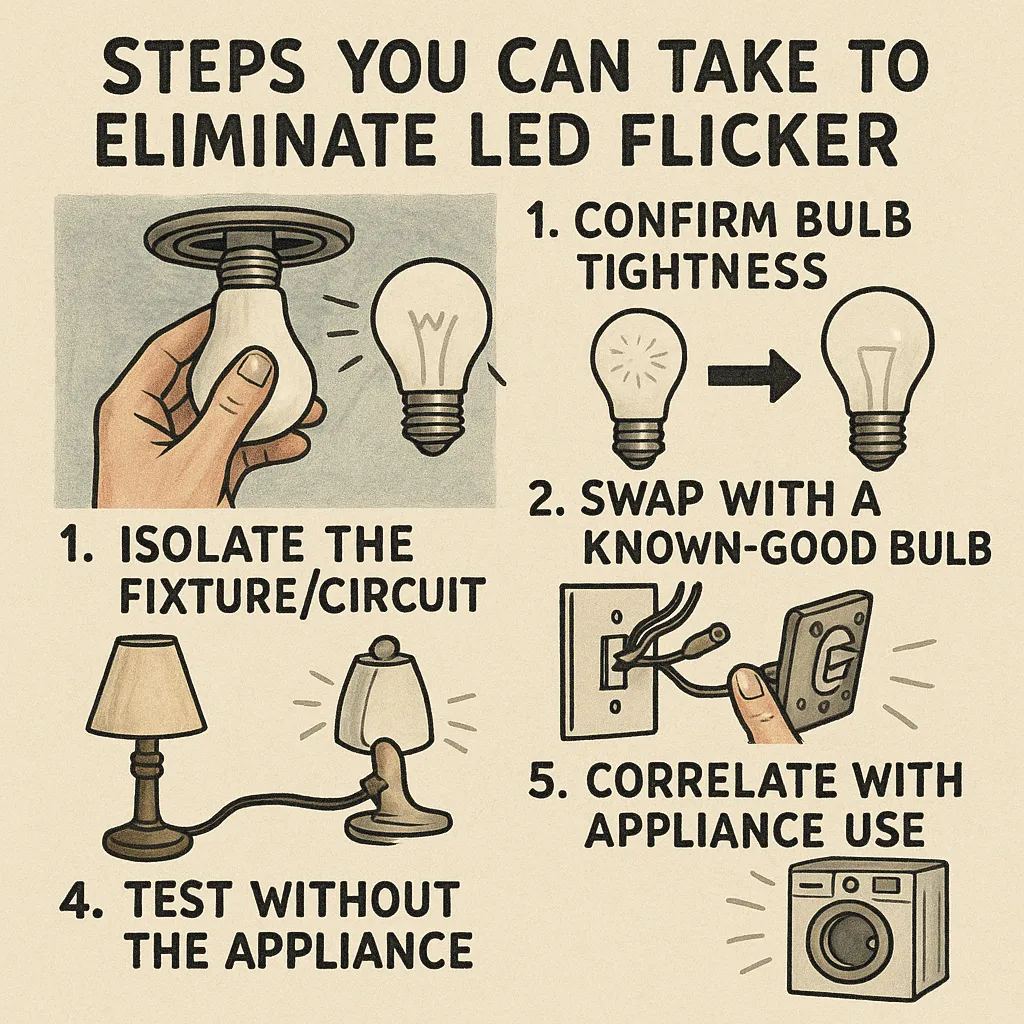
Basic Troubleshooting First
Start with the simple, non-invasive checks:
- Confirm Bulb Tightness: Ensure the bulb is firmly seated in its socket making good electrical contact.
- Swap with a Known-Good Bulb: Substitute the flickering bulb with one you know works correctly (ideally a different model or brand). If the problem vanishes, the original bulb (or its internal driver) was faulty. If the new bulb also flickers, the issue lies further up the chain (fixture wiring, switch, dimmer, circuit).
- Isolate the Fixture/Circuit: If it's a lamp, plug it into an outlet on a different circuit. If a hardwired fixture, consider (if feasible and safe) temporarily connecting it elsewhere. If the flicker follows the fixture, the fixture/bulb is the problem. If it stays with the original location, the circuit/wiring/switch is suspect.
- Test Without the Dimmer: If a dimmer is installed, turn off the power at the breaker. If you're competent with wiring, temporarily remove the dimmer and connect the hot (line) and switched leg (load) wires directly using appropriately sized wire nuts. Briefly restore power. If the flicker is gone, the dimmer (or its incompatibility) is the confirmed culprit. Attempt this only if you fully understand safe wiring practices.
- Correlate with Appliance Use: Note if flicker consistently coincides with large appliances starting. This strengthens the case for voltage drop on the circuit.
Fixing Specific Problems
Apply the fix that matches your diagnosis:
- Dimmer Issues: Replace the incompatible dimmer with one specifically designed for LEDs. Look for reputable brands and check compatibility (CL rating, trailing-edge, ELV/MLV specifications). Consult manufacturer compatibility lists online if possible.
- Bulb/Driver Quality: Invest in better-quality LED bulbs or fixtures. Seeking out products marketed as "flicker-free" or checking reviews for comments on flicker can help. Quality components make a difference.
- Voltage Fluctuations: If related to specific heavy loads, an electrician might recommend balancing loads across circuits or installing dedicated circuits for major appliances. Voltage regulators are rarely needed just for lighting unless voltage quality is exceptionally poor.
Handling Wiring Concerns Safely
Exercise extreme caution when inspecting any wiring.
- Visual Inspection (Power OFF): Shut off the correct circuit breaker. Carefully remove the device cover plate (switch, outlet) or fixture canopy. Look closely for loose wire nuts (give them a gentle tug), wires not secured under screw terminals, blackened connections, or melted insulation. Gently tighten screw terminals if needed. Replace any cracked or damaged wire nuts.
- Recognize Your Limits: Stop here unless you are a qualified electrician. Do not probe deeper into junction boxes within walls or attempt any modifications inside your electrical panel. The potential for severe shock or fire is real.
Knowing When to Call a Professional Electrician
Distinguishing between a simple fix and a potentially hazardous situation needing expert help is key. Don't hesitate when safety is involved.
Critical Warning Signs
These symptoms, especially accompanying flicker, demand an immediate call to a licensed electrician:
- Burning Odors: Any smell of burning plastic or ozone near switches, outlets, or fixtures.
- Audible Electrical Noises: Buzzing, sizzling, or crackling sounds from wiring devices or the panel.
- Overheating Devices: Switches, dimmers, or outlets that feel abnormally hot to the touch.
- Widespread or Multi-Circuit Flicker: Indicates a problem likely beyond a single fixture, possibly at the panel or with the service connection.
- Frequent Breaker Tripping: Especially on the circuit with the flickering lights.
- Highly Erratic Behavior: Extreme, unpredictable dimming or brightening alongside the flicker.
- Persistence After Basic Fixes: If simple troubleshooting doesn't resolve the issue, especially if wiring problems are suspected.
The Bottom Line on Safety
Use this guideline: If you lack experience, feel uncomfortable working with electricity, or the problem seems related to the building's fixed wiring system (not just a bulb or plug-in lamp), call a professional electrician. Their diagnostic tools and expertise ensure safe and correct repairs. It's the only responsible course of action when dealing with potentially hazardous electrical faults.
So, Are Flickering LED Lights Dangerous Overall? Assessing the Real Risk
We've looked at the health effects, the potential link to fire hazards, and the various causes. Let's circle back to the main question: are flickering LED lights dangerous when you consider everything? The realistic answer is nuanced.
- Flicker from Incompatibility or Low Quality: Often, flicker caused by a mismatched dimmer or a cheap LED bulb/driver is primarily an annoyance. It can certainly cause headaches, eye strain, and be particularly problematic for light-sensitive individuals, making it detrimental to well-being, but it doesn't typically represent an immediate electrical safety hazard like a fire risk in itself. The danger here is more about comfort, health impacts from prolonged exposure, and potentially triggering conditions like migraines or epilepsy in susceptible people.
- Flicker as a Symptom of Electrical Faults: This is where the "dangerous" part truly applies. When flickering stems from loose wiring, failing components generating heat, overloaded circuits, or significant voltage problems, it's acting as a visible warning sign of a potentially hazardous condition. These underlying electrical faults absolutely carry a risk of overheating, arcing, and potentially causing a fire. Ignoring this type of flicker is dangerous.
The takeaway here is that you cannot treat all flicker the same. You have to consider the context. Is it isolated to one new LED bulb on an old dimmer? Less likely to be an immediate fire hazard (though still needs addressing for comfort and potential health effects). Is it happening across multiple lights, accompanied by weird noises, or related to specific wiring you suspect is old or faulty? That warrants serious concern and likely professional investigation. Distinguishing between a simple nuisance and a genuine warning sign is the core of assessing the real risk.
Key Takeaways on Flickering LEDs
Boiling it all down, here’s what you need to remember about flickering LED lights:
- Flicker Has Multiple Causes: Don't assume it's always the bulb or always something serious. Incompatibility (especially with dimmers), driver quality, voltage issues, and wiring problems are all common culprits.
- Health Effects Are Real for Some: While often just annoying, flicker can contribute to headaches, eye strain, and pose specific risks for individuals with photosensitivity or migraines.
- Flicker CAN Signal Electrical Hazards: It's not the light pulse itself, but the underlying cause (like bad wiring or overheating parts) that can present a fire risk. Treat flicker as a potential warning sign.
- Troubleshoot Systematically: Start with simple checks (bulb tightness, swapping bulbs) before assuming complex problems.
- Prioritize Compatibility: When using dimmers, ensure both the dimmer and the LED bulbs are explicitly compatible. Check manufacturer recommendations.
- Invest in Quality: Reputable LED brands with good driver design are less likely to flicker. "Flicker-free" marketing can be helpful, but isn't always a guarantee – real-world performance matters.
- Know When to Stop and Call a Pro: Recognize the warning signs (smells, sounds, heat, widespread issues) and never hesitate to call a licensed electrician if you suspect problems with your home's fixed wiring or electrical system. Electrical safety is not a DIY area to gamble with.
Ultimately, addressing flickering LED lights isn't just about stopping an annoyance; it's about ensuring visual comfort, mitigating potential health effects, and, most importantly, identifying and correcting potentially hazardous electrical situations before they escalate.
Frequently Asked Questions (FAQ)
Q: What do "Flicker Percentage" and "Flicker Index" mean on LED specs?
A: These are technical metrics manufacturers sometimes use to quantify flicker. Flicker Percentage (or Percent Flicker) measures the relative intensity variation in light output over a single cycle (lower is better). Flicker Index is a more complex measure considering the shape of the light waveform (again, lower is better). While not always listed, very low values on these metrics usually indicate a "flicker-free" or low-flicker product, offering better visual comfort.
Q: Can flickering LED lights affect pets?
A: Animals, particularly birds (which have faster visual processing than humans), can be more sensitive to light flicker that humans might not even perceive. While definitive research is limited for common household pets like dogs and cats, significant flicker could potentially cause them stress or agitation. Choosing low-flicker lighting is generally considered more pet-friendly.
Q: Why do LED lights sometimes flicker on my phone camera but look fine in person?
A: This happens because the camera's shutter speed interacts with the rapid on/off cycles (flicker) of the LED light, even if the flicker is too fast for your eyes to detect directly. The camera captures "snapshots" of the light at different points in its cycle, making the flicker visible as banding or pulsing in the video or preview screen. It doesn't necessarily mean the flicker is harmful, just that the camera sees it differently than your eyes do.
Q: Are there official regulations or standards limiting LED flicker in lighting?
A: Regulations vary significantly by region and application. Some standards, like California's Title 24 building code in the US, have requirements limiting flicker (often measured by Flicker Percentage) for certain types of installed lighting to improve occupant comfort and health. Voluntary recommendations like IEEE 1789 also exist, providing guidance on acceptable flicker levels based on frequency and modulation. However, universal mandatory standards covering all LED products are not yet widespread globally.
Q: Do smart LED bulbs handle flickering differently than standard LEDs?
A: Smart bulbs contain more complex electronics, including microcontrollers and communication modules, in addition to the basic LED driver. While this could allow for more sophisticated flicker mitigation in high-quality designs, it also introduces more potential points of failure or software/firmware issues that could theoretically cause flicker. Compatibility issues with smart home systems or network instability might also manifest in unexpected ways, although flicker directly caused by the smart features themselves is less common than issues originating from the core driver or power supply quality, similar to standard LEDs.
Q: Can the color temperature (Kelvin) of LED light affect sleep, even if it's not flickering?
A: Yes. Light color temperature significantly impacts melatonin production, the hormone regulating sleep. Exposure to blue-rich, cool white light (typically 4000K and above) in the evening can suppress melatonin and make it harder to fall asleep. Using warm white light (typically 2700K to 3000K) in the hours before bed is generally recommended as it has less impact on sleep cycles. This is separate from flicker but relevant to overall lighting health.


